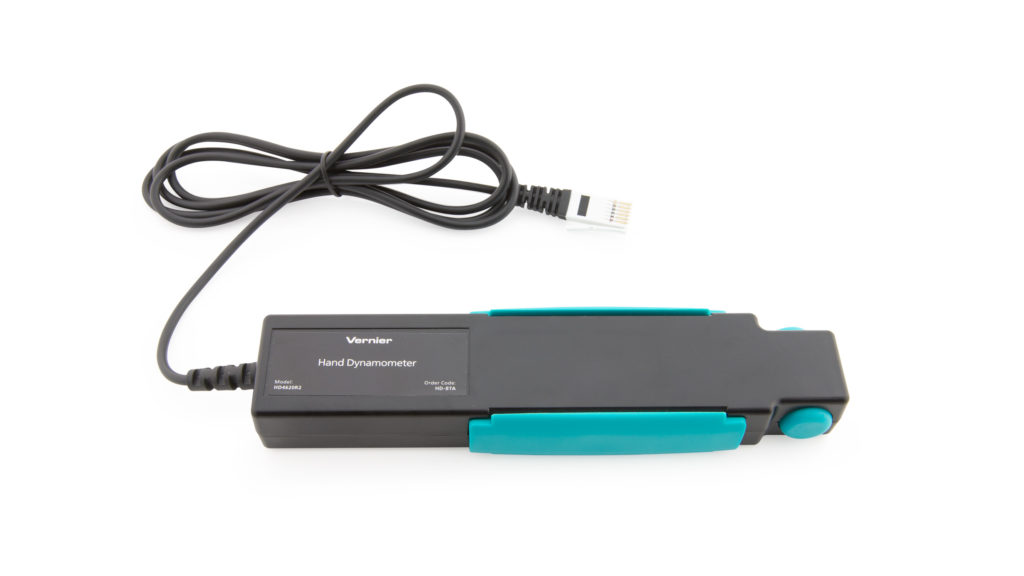Hand Dynamometer User Manual
Order Code: HD-BTA
The Hand Dynamometer can be used to measure grip strength or pinch strength and to perform muscle fatigue studies. Using the appropriate data-collection hardware and software, you can graph, record, calculate, and compare hand grip muscle fatigue rates. This sensor can be used alone or in combination with other sensors (e.g., EKG Sensor) for studies of muscular health and activity.
Note: Vernier products are designed for educational use. Our products are not designed nor are they recommended for any industrial, medical, or commercial process such as life support, patient diagnosis, control of a manufacturing process, or industrial testing of any kind.
What's Included
- Hand Dynamometer
Compatible Software and Interfaces
Choose a platform below to see its compatibility requirements.LabQuest
Interface LabQuest App LabQuest 3 Full support LabQuest 2 Full support LabQuest Full support Computers
Software Interface Graphical Analysis Graphical Analysis (Web App) Logger Pro (discontinued) Logger Lite (discontinued) LabQuest Mini Full support Full support Full support Full support LabQuest 3 Full support Full support Full support Incompatible LabQuest 2 Full support Full support Full support Full support LabQuest Stream Full support 1 Full support 1 Partial support 2 Full support 1 Go!Link Full support Full support Full support Full support LabQuest Full support Full support Full support Full support LabPro Incompatible Incompatible Full support Full support Compatibility Notes
Chromebook
Software Interface Graphical Analysis (Web App) LabQuest Mini Full support LabQuest 3 Full support LabQuest 2 Full support LabQuest Stream Full support 1 Go!Link Full support LabQuest Full support Compatibility Notes
iOS
Software Interface Graphical Analysis Graphical Analysis GW LabQuest Stream Full support Full support LabQuest 3 Full support 1 Full support 1 LabQuest 2 Full support 1 Full support 1 Compatibility Notes
Android
Software Interface Graphical Analysis Graphical Analysis GW LabQuest Stream Full support Full support LabQuest 3 Full support 1 Full support 1 LabQuest 2 Full support 1 Full support 1 Compatibility Notes
Arduino
Software Interface Arduino Vernier Arduino® Interface Shield Full support LabVIEW
Software Interface NI LabVIEW SensorDAQ Full support Vernier myDAQ Adapter Full support 1 Go!Link Full support LabQuest Mini Full support LabQuest Stream Full support LabQuest 3 Full support LabQuest 2 Full support LabQuest Full support Compatibility Notes
Texas Instruments
Software Interface EasyData DataMate TI-84 SmartView DataQuest TI-Nspire Software EasyLink Full support 1 Incompatible Full support 2 Full support Full support 2 CBL 2 Full support 3 Full support 3 4 Incompatible Incompatible Incompatible LabPro Full support 3 Full support 3 4 Incompatible Incompatible Incompatible TI-Nspire Lab Cradle Incompatible Incompatible Incompatible Full support Full support Compatibility Notes
Getting Started
- Connect the sensor to the interface (LabQuest Mini, LabQuest 3, etc.).
- Start the appropriate data-collection software (Vernier Graphical Analysis®, LabQuest® App, or Logger Pro™) if not already running, and choose New from File menu. The software will identify the sensor and load a default data‑collection setup. You are now ready to collect data.
If you are collecting data using a Chromebook™, mobile device such as iPad® or Android™ tablet, or a Vernier wireless interface, please see the following link for up-to-date connection information:
Using the Product
Connect the sensor following the steps in the Getting Started section of this user manual.
The Hand Dynamometer can be used to measure grip strength or pinch strength.
Grip strength is assessed by holding the sensor in a vertical position with the arm perpendicular to the body and fingers on the pad distal to the longer proximal portion to which the palm is pressed. Strength can be measured by applying pressure for a series of short grasps or over a sustained duration.
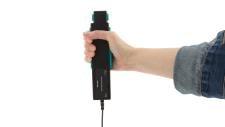
To assess pinch strength, hold the sensor in one hand by the case avoiding contact with the pads. Using your thumb and forefinger of the opposite hand, place each on the opposing pinch pads and squeeze.
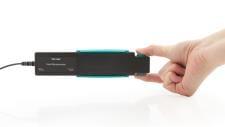
Potential Uses for this Sensor
The following is a list of activities and experiments that can be performed using this sensor.
- Determine if grip and pinch strength are a function of age.
- Compare hand grip strength with pinch strength. Devise and carry out a study to explore if there is a correlation between them.
- Measure muscle fatigue by exerting maximum grip strength and sustained grasp for as long as possible. Determine if muscle fatiguing time is similar for all participants and if there is variation between age groupings and gender. Predict the results of repeated trials for each member of the group.
- Measure the effect of squeezing a tennis ball repeatedly on grip strength. Squeeze the ball tightly each evening fifty times for a month. At the beginning of the month, measure and record your basal grip strength; at the end of the month, record your hand grip strength and analyze how these values compare.
- Determine if there is a correlation between hand size and grip strength. Consider factors such as wrist and forearm circumference in relation to grip strength and which muscle complexes are involved in grip strength and pinch strength.
- Measure hand grip strength for dominant and non-dominant hands by gripping the dynamometer in a neutral non-supportive posture with the sensor in your non-dominant hand. Initiate data collection while holding the sensor with a neutral grip with eyes closed. Explore what accounts for the similarities and differences.
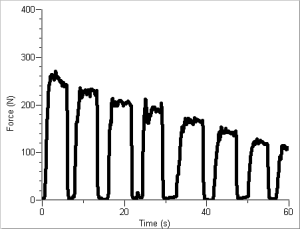
Muscle fatigue
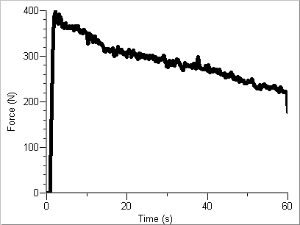
Fatigue over time
Videos
Calibration
You should not have to perform a new calibration when using the Hand Dynamometer. We have set the sensor to match our stored calibration before shipping it. You can simply use the appropriate calibration value that is stored in the data-collection program.
Specifications
|
Default calibration (N) |
|
|
Default calibration (kg) |
|
|
Default calibration (lbs) |
|
|
12-bit resolution |
0.2159 N |
|
Power |
7 mA @ 5VDC |
|
Safety range (maximum force without damage to the sensor) |
0 to 850 N |
|
Operational range: |
0 to 600 N |
How the Sensor Works
The Hand Dynamometer is a strain-gauge based isometric force sensor. This sensor amplifies the force applied converting it into a voltage that is monitored by the interface and read in the desired units of force. The Hand Dynamometer reports values in newtons (N), pounds (lb), or kilograms (kg).
Troubleshooting
- If the sensor does not read zero in the orientation in which you are using it, follow the standard zeroing procedure for the data‑collection program you are using.
- If the default experiment length is too long for your experiment, set the data‑collection parameters in the program you are using.
For additional troubleshooting and FAQs, see www.vernier.com/til/1431
Repair Information
If you have watched the related product video(s), followed the troubleshooting steps, and are still having trouble with your Hand Dynamometer, contact Vernier Technical Support at support@vernier.com or call 888-837-6437. Support specialists will work with you to determine if the unit needs to be sent in for repair. At that time, a Return Merchandise Authorization (RMA) number will be issued and instructions will be communicated on how to return the unit for repair.
Warranty
Warranty information for this product can be found on the Support tab at www.vernier.com/hd-bta/#support
General warranty information can be found at www.vernier.com/warranty
Contact Support
Fill out our online support form or call us toll-free at 1-888-837-6437.

